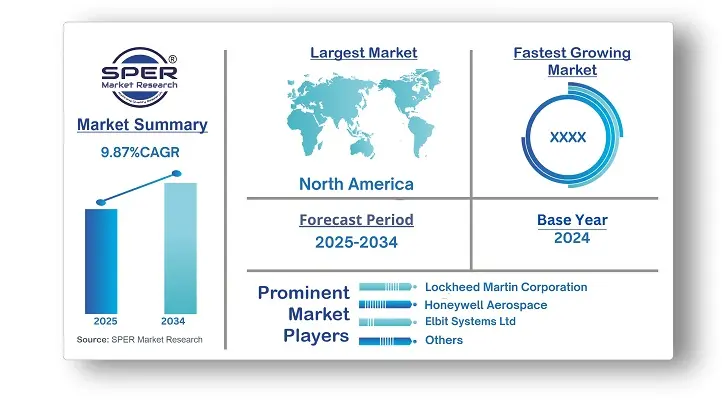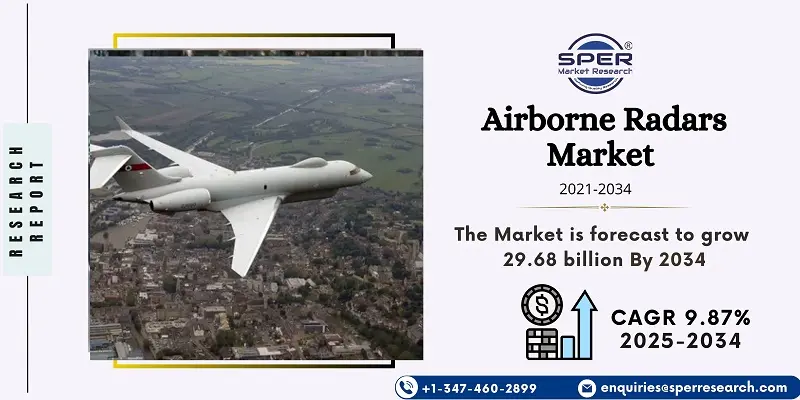
Airborne Radars Market Size, Share, Growth, Industry Report and Investment Opportunities 2034
Airborne Radars Market Growth, Size, Trends Analysis - By Component, By Mode, By Dimension, By Range, By Frequency Band, By Installation Type, By Application, By Technology - Regional Outlook, Competitive Strategies and Segment Forecast to 2034
| Published: May-2025 | Report ID: SEMI2522 | Pages: 1 - 244 | Formats*: |
| Category : Semiconductor and Electronics | |||


| Report Metric | Details |
| Market size available for years | 2021-2034 |
| Base year considered | 2024 |
| Forecast period | 2025-2034 |
| Segments covered | By Component, By Mode, By Dimension, By Range, By Frequency Band, By Installation |
| Regions covered | North America, Latin America, Asia-Pacific, Europe, and Middle East & Africa |
| Companies Covered | Lockheed Martin Corporation, Thales, Leonardo S.p.A.., Honeywell Aerospace, L3Harris Technologies, Inc., Elbit Systems Ltd., Israel Aerospace Industries, Indra, Telephonics Corporation, OPTIMARE Systems GmbH, Echodyne Corp. |
- Global Airborne Radars Market Size (FY’2021-FY’2034)
- Overview of Global Airborne Radars Market
- Segmentation of Global Airborne Radars Market By Component (Antennas, Receivers, Processors, Transmitters, Graphical User Interfaces, Stabilization Systems)
- Segmentation of Global Airborne Radars Market By Mode (Air-to-Ground, Air-to-Air, Air-to-Sea)
- Segmentation of Global Airborne Radars Market By Dimension (2D, 3D, 4D)
- Segmentation of Global Airborne Radars Market By Range (Long Range, Medium Range, Short Range, Very Short Range)
- Segmentation of Global Airborne Radars Market By Frequency Band (X-band, C-band, KU-band, S-band, HF/VHF/UHF, KA-band, Multi-band, L-band)
- Segmentation of Global Airborne Radars Market By Installation Type (New Installation, Retrofit)
- Segmentation of Global Airborne Radars Market By Application (Defense and Military, Commercial and Business)
- Segmentation of Global Airborne Radars Market By Technology (Active Electronically Scanned Array, Software-Defined Radar, Synthetic Aperture Radar, Digital Beam forming, Multistatic Radar Systems, Low Probability of Intercept)
- Statistical Snap of Global Airborne Radars Market
- Expansion Analysis of Global Airborne Radars Market
- Problems and Obstacles in Global Airborne Radars Market
- Competitive Landscape in the Global Airborne Radars Market
- Details on Current Investment in Global Airborne Radars Market
- Competitive Analysis of Global Airborne Radars Market
- Prominent Players in the Global Airborne Radars Market
- SWOT Analysis of Global Airborne Radars Market
- Global Airborne Radars Market Future Outlook and Projections (FY’2025-FY’2034)
- Recommendations from Analyst
1. Introduction
1.1. Scope of the report
1.2. Market segment analysis
2. Research Methodology
2.1. Research data source
2.1.1. Secondary Data
2.1.2. Primary Data
2.1.3. SPER’s internal database
2.1.4. Premium insight from KOL’s
2.2. Market size estimation
2.2.1. Top-down and Bottom-up approach
2.3. Data triangulation
3. Executive Summary
4. Market Dynamics
4.1. Driver, Restraint, Opportunity and Challenges analysis
4.1.1. Drivers
4.1.2. Restraints
4.1.3. Opportunities
4.1.4. Challenges
5. Market variable and outlook
5.1. SWOT Analysis
5.1.1. Strengths
5.1.2. Weaknesses
5.1.3. Opportunities
5.1.4. Threats
5.2. PESTEL Analysis
5.2.1. Political Landscape
5.2.2. Economic Landscape
5.2.3. Social Landscape
5.2.4. Technological Landscape
5.2.5. Environmental Landscape
5.2.6. Legal Landscape
5.3. PORTER’s Five Forces
5.3.1. Bargaining power of suppliers
5.3.2. Bargaining power of buyers
5.3.3. Threat of Substitute
5.3.4. Threat of new entrant
5.3.5. Competitive rivalry
5.4. Heat Map Analysis
6. Competitive Landscape
6.1. Global Airborne Radars Market Manufacturing Base Distribution, Sales Area, Product Type
6.2. Mergers & Acquisitions, Partnerships, Product Launch, and Collaboration in Global Airborne Radars Market
7. Global Airborne Radars Market, By Component 2021-2034 (USD Million)
7.1. Antennas
7.2. Receivers
7.3. Processors
7.4. Transmitters
7.5. Graphical User Interfaces
7.6. Stabilization Systems
8. Global Airborne Radars Market, By Mode 2021-2034 (USD Million)
8.1. Air-to-Ground
8.2. Air-to-Air
8.3. Air-to-Sea
9. Global Airborne Radars Market, By Dimension 2021-2034 (USD Million)
9.1. 2D
9.2. 3D
9.3. 4D
10. Global Airborne Radars Market, By Range 2021-2034 (USD Million)
10.1. Long Range
10.2. Medium Range
10.3. Short Range
10.4. Very Short Range
11. Global Airborne Radars Market, By Frequency Band 2021-2034 (USD Million)
11.1. X-band
11.2. C-band
11.3. KU-band
11.4. S-band
11.5. HF/VHF/UHF
11.6. KA-band
11.7. Multi-band
11.8. L-band
12. Global Airborne Radars Market, By Installation Type 2021-2034 (USD Million)
12.1. New Installation
12.2. Retrofit
13. Global Airborne Radars Market, By Application 2021-2034 (USD Million)
13.1. Defense and Military
13.1.1. Combat Aircraft
13.1.2. Special Mission
13.1.3. Transport Aircraft
13.1.4. Helicopters
13.1.5. Unmanned Aerial Vehicles (UAVs)
13.1.6. Aerostats
13.2. Commercial and Business
13.2.1. Body Aircraft
13.2.2. Wide Body Aircraft
13.2.3. Jets
13.2.4. Helicopters
13.2.5. Urban Air Mobility (UAM)
13.2.6. Aerostats
14. Global Airborne Radars Market, By Technology 2021-2034 (USD Million)
14.1. Active Electronically Scanned Array
14.2. Software-Defined Radar
14.3. Synthetic Aperture Radar
14.4. Digital Beam forming
14.5. Multistatic Radar Systems
14.6. Low Probability of Intercept
15. Global Airborne Radars Market, 2021-2034 (USD Million)
15.1. Global Airborne Radars Market Size and Market Share
16. Global Airborne Radars Market, By Region, 2021-2034 (USD Million)
16.1. Asia-Pacific
16.1.1. Australia
16.1.2. China
16.1.3. India
16.1.4. Japan
16.1.5. South Korea
16.1.6. Rest of Asia-Pacific
16.2. Europe
16.2.1. France
16.2.2. Germany
16.2.3. Italy
16.2.4. Spain
16.2.5. United Kingdom
16.2.6. Rest of Europe
16.3. Middle East and Africa
16.3.1. Kingdom of Saudi Arabia
16.3.2. United Arab Emirates
16.3.3. Qatar
16.3.4. South Africa
16.3.5. Egypt
16.3.6. Morocco
16.3.7. Nigeria
16.3.8. Rest of Middle-East and Africa
16.4. North America
16.4.1. Canada
16.4.2. Mexico
16.4.3. United States
16.5. Latin America
16.5.1. Argentina
16.5.2. Brazil
16.5.3. Rest of Latin America
17. Company Profile
17.1. Echodyne Corp.
17.1.1. Company details
17.1.2. Financial outlook
17.1.3. Product summary
17.1.4. Recent developments
17.2. Elbit Systems Ltd.
17.2.1. Company details
17.2.2. Financial outlook
17.2.3. Product summary
17.2.4. Recent developments
17.3. Hensoldt
17.3.1. Company details
17.3.2. Financial outlook
17.3.3. Product summary
17.3.4. Recent developments
17.4. Honeywell Aerospace
17.4.1. Company details
17.4.2. Financial outlook
17.4.3. Product summary
17.4.4. Recent developments
17.5. Israel Aerospace Industries
17.5.1. Company details
17.5.2. Financial outlook
17.5.3. Product summary
17.5.4. Recent developments
17.6. Leonardo S.p.A.
17.6.1. Company details
17.6.2. Financial outlook
17.6.3. Product summary
17.6.4. Recent developments
17.7. Lockheed Martin Corporation
17.7.1. Company details
17.7.2. Financial outlook
17.7.3. Product summary
17.7.4. Recent developments
17.8. L3Harris Technologies, Inc.
17.8.1. Company details
17.8.2. Financial outlook
17.8.3. Product summary
17.8.4. Recent developments
17.9. OPTIMARE Systems GmbH
17.9.1. Company details
17.9.2. Financial outlook
17.9.3. Product summary
17.9.4. Recent developments
17.10. Telephonics Corporation
17.10.1. Company details
17.10.2. Financial outlook
17.10.3. Product summary
17.10.4. Recent developments
17.11. Others
18. Conclusion
19. List of Abbreviations
20. Reference Links
SPER Market Research’s methodology uses great emphasis on primary research to ensure that the market intelligence insights are up to date, reliable and accurate. Primary interviews are done with players involved in each phase of a supply chain to analyze the market forecasting. The secondary research method is used to help you fully understand how the future markets and the spending patterns look likes.
The report is based on in-depth qualitative and quantitative analysis of the Product Market. The quantitative analysis involves the application of various projection and sampling techniques. The qualitative analysis involves primary interviews, surveys, and vendor briefings. The data gathered as a result of these processes are validated through experts opinion. Our research methodology entails an ideal mixture of primary and secondary initiatives.



Frequently Asked Questions About This Report
PLACE AN ORDER
Year End Discount
Sample Report
Pre-Purchase Inquiry
NEED CUSTOMIZATION?
Request CustomizationCALL OR EMAIL US
100% Secure Payment






Related Reports
Our Global Clients
Our data-driven insights have influenced the strategy of 200+ reputed companies across the globe.






















